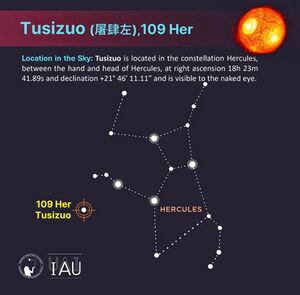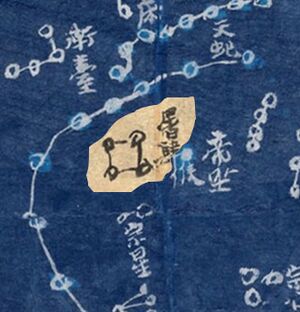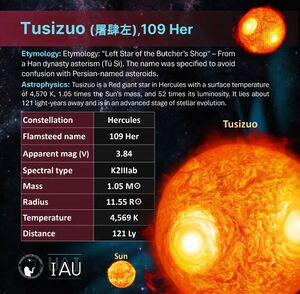Tusizuo: Difference between revisions
No edit summary |
Ericmamajek (talk | contribs) (updated some description of the importance of the star and comments on its reported multiplicity (or lack thereof)) |
||
| (3 intermediate revisions by one other user not shown) | |||
| Line 1: | Line 1: | ||
[[File:Tusizuo profile stickfigure.jpeg|alt=WGSN profile card - map of Tusizuo|thumb|WGSN star name "Tusizuo", profile stickfigure, created by M. Sadegh Faghanpour (IAU WGSN).]] |
|||
[[File:Tusi and Bodu on Dunhuang Star Map.jpg|thumb|Tusi and Bodu on Dunhuang Star Map]] |
|||
Tusizuo is a modern star name adopted to the IAU-Catalog of Star Names in 2025 to memorize the historical constellation Tú Sì (屠肆, "Butcher's Shop"). |
Tusizuo, "The Left Star of the Butcher Shop", is a modern star name adopted to the IAU-Catalog of Star Names in 2025 for the star 109 Her in [[Hercules]] to memorize the historical Chinese constellation [[Tusi|Tú Sì (屠肆]], "Butcher's Shop") in the superconstellation of Tianshi, The Heavenly Market. |
||
==Etymology and History== |
== Etymology and History== |
||
The old constellation Tú Sì (屠肆, "Butcher's Shop") is a Chinese asterism consisting of two stars, established by the Wuxian (巫咸) school during the Han dynasty. Among these two stars, one is named "the left" and the other "the right one". |
[[File:Tusi and Bodu on Dunhuang Star Map.jpg|thumb|Tusi and Bodu on Dunhuang Star Map]] The old constellation Tú Sì (屠肆, "Butcher's Shop") is a Chinese asterism consisting of two stars, established by the Wuxian (巫咸) school during the Han dynasty. Among these two stars, one is named "the left" and the other "the right one". |
||
==The Star == |
|||
109 Her is a red giant star of one solar mass, so it displays what our Sun will look like in roughly 5 billion years: the entire mass filling a sphere with roughly twelve solar radii. The star is at a distance of 121 light years, so the light that was observed in the year of WGSN-naming left the star's surface one year before Einstein published his theory of special relativity and the fundamental equation of the photoelectric effect for which he obtained the Nobel prize. |
|||
This red giant star is one of the stars that defines the spectral type K2IIIab, in the catalog of spectral standard stars by [https://ui.adsabs.harvard.edu/abs/1989ApJS...71..245K/abstract Philip Keenan and Raymond McNeil (1989)], where the type "K" implies a star somewhat cooler and oranger than our Sun, and the luminosity class III implies the star has a surface gravity consistent with being a giant. |
|||
Although 109 Her / Tusizuo appears in the Washington Double Star catalog (WDS J18237+2146; with 109 Her as component "A" or "Aa"), the evidence that any of the three reported companions is physically associated with the star has been weak. The "B" and "C" components appear to be faint background stars at wide separations (238" and 129", respectively) that do not share the fast proper motion of "A". The "A" component itself was reported to be tight binary (designated TOK 60 Aa,Ab) in a single speckle interferometry observation in 2009 by [https://ui.adsabs.harvard.edu/abs/2010AJ....139..743T/abstract Tokovinin et al. (2010)], with separation 0.042 arcseconds and a companion 1.6 magnitudes fainter (in an Halpha filter). However, subsequent observations by Tokovinin in 2018 and 2021 did not recover the companion. If the Tokovinin speckle companion was real, then the secondary would also be likely to be a giant star of similar mass, and then 107 Her should show radial velocity variations of tens of kilometers per second on timescales of ~1-few years. However, no such periodicity has been reported in published radial velocity data for 109 Her, despite multiple investigators reporting relatively steady velocities at the ~km/s-level over the past century (e.g. [https://ui.adsabs.harvard.edu/abs/1986ApJS...62..147B/abstract Beavers & Eitter 1986]). Lastly, a comparison of the star's proper motion by the ESA Hipparcos and Gaia missions by [https://ui.adsabs.harvard.edu/abs/2022A%26A...657A...7K/abstract Kervella et al. (2022)] was consistent with single star motion (the measured tangential velocity anomaly was statistically insignificant: 35+-19 meters per second). |
|||
==Mythology== |
|||
So thus far, 109 Her appears to be single. |
|||
==IAU Working Group on Star Names== |
==IAU Working Group on Star Names== |
||
[[File:Tusizuo profileWGSN.jpeg|alt=WGSN profile card of Tusizuo|thumb|WGSN star name "Tusizuo", profile card, created by M. Sadegh Faghanpour (IAU WGSN).]] |
|||
The constellation name was discussed |
The constellation name was discussed as a possible source of a star name by IAU WGSN in 2025. As "Tusi" could be confused with other celestial bodies named Tusi after two Persian astronomers (asteroid (10269) Tusi and asteroid (7058) Al-Tusi), WGSN chose to add a determinative here, and adopted the Chinese name '''Tusizuo''', for "''the left one in Tú Sì (屠肆, 'Butcher's Shop')''", for the star designated 109 Her (aliases: HR 6895, HD 169414, HIP 90139). |
||
==Weblinks== |
|||
*[https://simbad.cds.unistra.fr/simbad/sim-id?Ident=109+Her SIMBAD page for 109 Her] |
|||
*[[wikipedia:109_Herculis|Wikipedia page (English) on 109 Her]] |
|||
== |
==Reference== |
||
| ⚫ | |||
| ⚫ | |||
* |
|||
== Reference == |
|||
| ⚫ | |||
| ⚫ | |||
[[Category:Single star-asterism]] |
[[Category:Single star-asterism]] |
||
Latest revision as of 07:16, 9 August 2025
Tusizuo, "The Left Star of the Butcher Shop", is a modern star name adopted to the IAU-Catalog of Star Names in 2025 for the star 109 Her in Hercules to memorize the historical Chinese constellation Tú Sì (屠肆, "Butcher's Shop") in the superconstellation of Tianshi, The Heavenly Market.
Etymology and History
The old constellation Tú Sì (屠肆, "Butcher's Shop") is a Chinese asterism consisting of two stars, established by the Wuxian (巫咸) school during the Han dynasty. Among these two stars, one is named "the left" and the other "the right one".
The Star
109 Her is a red giant star of one solar mass, so it displays what our Sun will look like in roughly 5 billion years: the entire mass filling a sphere with roughly twelve solar radii. The star is at a distance of 121 light years, so the light that was observed in the year of WGSN-naming left the star's surface one year before Einstein published his theory of special relativity and the fundamental equation of the photoelectric effect for which he obtained the Nobel prize.
This red giant star is one of the stars that defines the spectral type K2IIIab, in the catalog of spectral standard stars by Philip Keenan and Raymond McNeil (1989), where the type "K" implies a star somewhat cooler and oranger than our Sun, and the luminosity class III implies the star has a surface gravity consistent with being a giant.
Although 109 Her / Tusizuo appears in the Washington Double Star catalog (WDS J18237+2146; with 109 Her as component "A" or "Aa"), the evidence that any of the three reported companions is physically associated with the star has been weak. The "B" and "C" components appear to be faint background stars at wide separations (238" and 129", respectively) that do not share the fast proper motion of "A". The "A" component itself was reported to be tight binary (designated TOK 60 Aa,Ab) in a single speckle interferometry observation in 2009 by Tokovinin et al. (2010), with separation 0.042 arcseconds and a companion 1.6 magnitudes fainter (in an Halpha filter). However, subsequent observations by Tokovinin in 2018 and 2021 did not recover the companion. If the Tokovinin speckle companion was real, then the secondary would also be likely to be a giant star of similar mass, and then 107 Her should show radial velocity variations of tens of kilometers per second on timescales of ~1-few years. However, no such periodicity has been reported in published radial velocity data for 109 Her, despite multiple investigators reporting relatively steady velocities at the ~km/s-level over the past century (e.g. Beavers & Eitter 1986). Lastly, a comparison of the star's proper motion by the ESA Hipparcos and Gaia missions by Kervella et al. (2022) was consistent with single star motion (the measured tangential velocity anomaly was statistically insignificant: 35+-19 meters per second).
So thus far, 109 Her appears to be single.
IAU Working Group on Star Names
The constellation name was discussed as a possible source of a star name by IAU WGSN in 2025. As "Tusi" could be confused with other celestial bodies named Tusi after two Persian astronomers (asteroid (10269) Tusi and asteroid (7058) Al-Tusi), WGSN chose to add a determinative here, and adopted the Chinese name Tusizuo, for "the left one in Tú Sì (屠肆, 'Butcher's Shop')", for the star designated 109 Her (aliases: HR 6895, HD 169414, HIP 90139).







